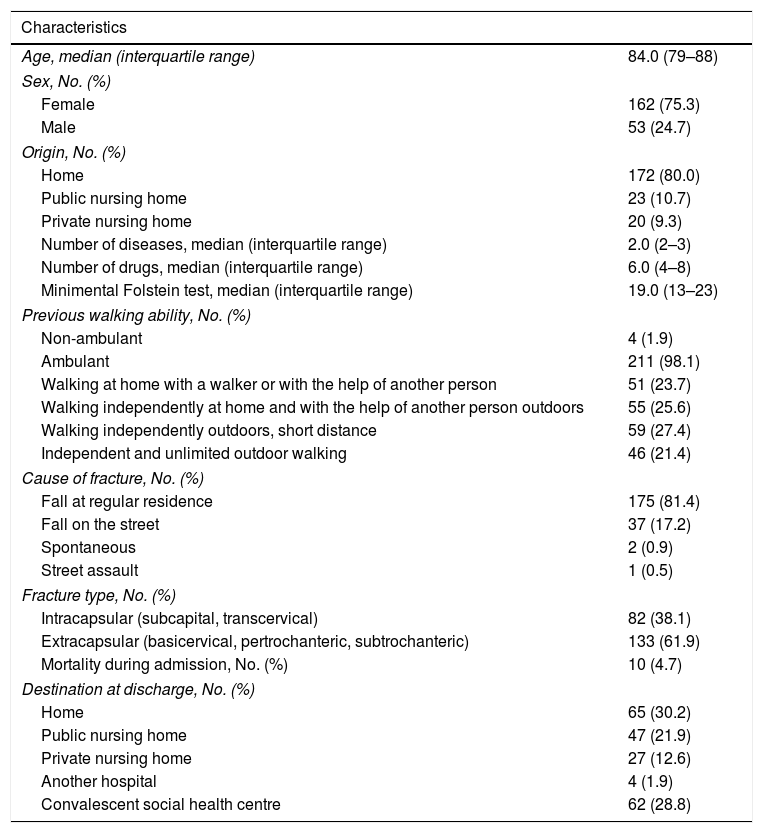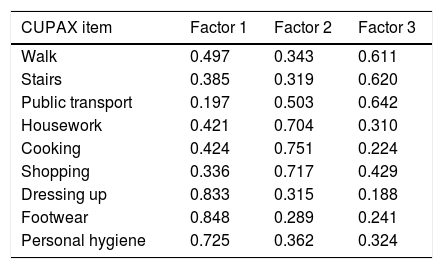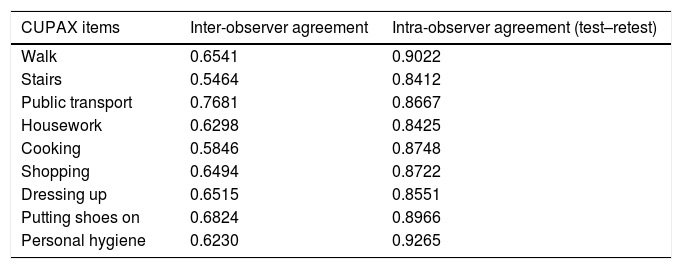Hip fractures in elderly patients are very frequent and are associated with high morbidity and mortality. We do not have validated instruments in Spanish that can faithfully assess functional capacity prior to fracture. The aim of this study was to develop and validate the CUPAX questionnaire in elderly patients with a hip fracture.
Materials and methodsProspective and observational validation study. We included 215 patients older than 65 years, who were admitted to our centre after suffering a hip fracture. They were evaluated using the CUPAX questionnaire, Barthel Index and Parker Score. The statistical study was performed to corroborate the validity and reliability of the questionnaire.
ResultsThe median age of the patient population was 84.0 years (75.3% women). The majority were patients who had suffered an extracapsular fracture; they had walking capacity and suffered a fall in their place of residence. The statistical analysis on the validity and reliability of the questionnaire obtained the following results: Cronbach's alpha coefficient showed excellent internal consistency (value of 0.94). Factor analysis showed 3 underlying factors. The interobserver intraclass correlation coefficient (ICC) was 0.82 (95% CI: 0.75–0.87), and the intraobserver ICC was 0.96 (95% CI: 0.95–0.97). Correlation with other functional scales was assessed using the Spearman correlation coefficient, which was 0.83 with the Barthel Index and 0.81 with the Parker score.
ConclusionsThese findings support the validity of the CUPAX questionnaire as a tool to measure the previous functional level in elderly patients affected by a hip fracture.
Las fracturas de cadera en pacientes ancianos tienen una elevada frecuencia y morbimortalidad. No disponemos de instrumentos validados en castellano que puedan valorar fielmente la capacidad funcional previa a la fractura. El objetivo de este estudio fue desarrollar y validar el cuestionario CUPAX en pacientes ancianos con fractura de cadera.
Materiales y métodosEstudio de validación observacional y prospectivo. Se incluyó a 215 pacientes mayores de 65 años, que ingresaron en nuestro centro tras sufrir una fractura de cadera. Se evaluaron mediante el cuestionario CUPAX, índice de Barthel y score de Parker. Se realizó el estudio estadístico para valorar la validez y fiabilidad del cuestionario.
ResultadosLa edad mediana de la muestra fue 84 años (75,3% mujeres). La mayoría de los pacientes presentaban fractura de localización extracapsular, eran previamente deambulantes y sufrían la caída en su domicilio. El estudio estadístico sobre la validez y la fiabilidad del cuestionario obtuvo los siguientes resultados. El coeficiente alfa de Cronbach mostró una excelente consistencia interna (valor de 0,94). El análisis factorial mostró 3 factores subyacentes. El coeficiente de correlación intraclase (CCI) interobservador fue 0,82 (IC del 95%: 0,75-0,87) y el CCI intraobservador fue 0,96 (IC del 95%: 0,95-0,97). La correlación con otras escalas funcionales fue valorada mediante el coeficiente de correlación de Spearman: 0,83 con el índice de Barthel y 0,81 con el score de Parker.
ConclusionesEstos hallazgos apoyan la validez del cuestionario CUPAX como herramienta de valoración del nivel funcional previo en pacientes ancianos afectados de fractura de cadera.
Artículo
Comprando el artículo el PDF del mismo podrá ser descargado
Precio 19,34 €
Comprar ahora












